Related Research Articles

Liskeard railway station serves the town of Liskeard in Cornwall, England. The station is approximately 18 miles (29 km) west of Plymouth on the Cornish Main Line and 264 miles 71 chains (426.3 km) from London Paddington via Box and Plymouth Millbay. It is the junction for the Looe Valley Line. The railway station is situated approximately 0.5 miles (0.80 km) south-west of Liskeard town centre.

Wangaratta railway station is located on the North East line in Victoria, Australia. It serves the town of the same name, and opened on 28 October 1873.

The Devon and Somerset Railway (D&SR) was a cross-country line that connected Barnstaple in Devon, England, to the network of the Bristol and Exeter Railway (B&ER) near Taunton. It was opened in stages between 1871 and 1873 and closed in 1966. It served a mostly rural area although it carried some through services from east of Taunton to the seaside resort of Ilfracombe.

Barnoldswick railway station was the only railway station on the Midland Railway's 1-mile-64-chain (2.9 km) long Barnoldswick Branch in the West Riding of Yorkshire in England. It served the market town of Barnoldswick, which was in West Riding of Yorkshire at the time. The line left the Leeds and Bradford Extension Railway at Barnoldswick Junction 55 chains from Earby railway station. The line through the junction was on a 20-chain radius after which it converged to a single track and ran in a straight but undulating line to Barnoldswick. The passenger train that ran back and forth between Barnoldswick and Earby was known locally as the 'Barlick Spud' or 'Spudroaster'. The real reason for the name is lost in time, but the two versions that were commonly recited are that the original branch locomotive was so small it looked like a portable potato roaster used by a local vendor or that the journey time was the same as that taken to roast a potato in the locomotive's firebox.
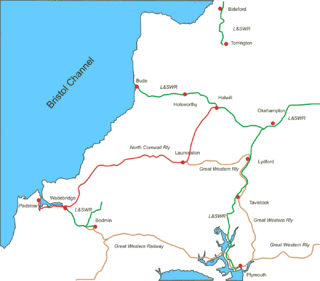
The North Cornwall Railway was a railway line running from Halwill in Devon to Padstow in Cornwall via Launceston, Camelford and Wadebridge, a distance of 49 miles 67 chains. Opened in the last decade of the nineteenth century, it was part of a drive by the London and South Western Railway (LSWR) to develop holiday traffic to Cornwall. The LSWR had opened a line connecting Exeter with Holsworthy in 1879, and by encouraging the North Cornwall Railway it planned to create railway access to previously inaccessible parts of the northern coastal area.
There are 22 disused railway stations on the Bristol to Exeter line between Bristol Temple Meads and Exeter St Davids. The line was completed in 1844 at which time the temporary terminus at Beambridge was closed. The most recent closure was Tiverton Junction which was replaced by a new station} on a different site in 1986. 12 of the disused stations have structures that can still be seen from passing trains.
There are seventeen disused railway stations on the Cornish Main Line between Plymouth in Devon and Penzance in Cornwall, England. The remains of nine of these can be seen from passing trains. While a number of these were closed following the so-called "Beeching Axe" in the 1960s, many of them had been closed much earlier, the traffic for which they had been built failing to materialise.
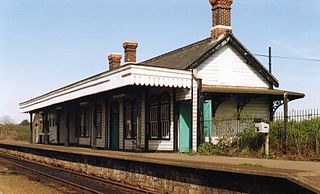
Felixstowe Beach is a disused railway station which served the seafront and southern part of Felixstowe in Suffolk, England. First opened in 1877, the station closed to freight on 5 December 1966 and to passenger traffic on 11 September 1967. The line remains open and sidings to the south of the station connect with railway lines in the Port of Felixstowe.
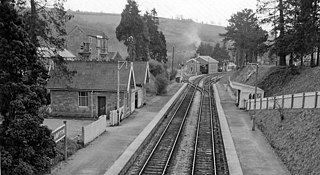
The Exe Valley Railway was a branch line built by the Great Western Railway (GWR) in Devon, England, to link its Bristol to Exeter line with its Devon and Somerset Railway (D&SR), thereby connecting Exeter with Dulverton. The line was in use from 1884 until 1964.
The Whittingham Hospital Railway (W.H.R.) was a private light railway operated by Lancashire County Council to serve Whittingham lunatic asylum. Opened in 1889, it carried goods and passengers between Grimsargh on the Preston and Longridge Railway and the hospital grounds. It closed to all traffic in 1957.
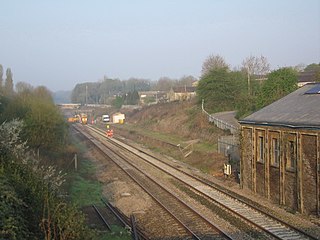
Corsham railway station served the town of Corsham in Wiltshire, England, between 1841 and 1965. Feasibility studies for the reopening of the station have been under way since 2021.
Southfleet was a railway station on the Gravesend West Line which served the small village of Southfleet in Kent, England.

The Stainland branch was built by the Lancashire and Yorkshire Railway and linked Greetland with Stainland and Holywell Green. It served the villages of Greetland, West Vale, Holywell Green and Stainland.
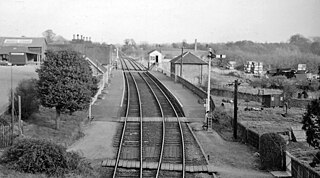
Brackley Town was a railway station which served the Northamptonshire town of Brackley in England. It opened in 1850 as part of the Buckinghamshire Railway's branch line to Verney Junction which provided connections to Banbury, Bletchley and Oxford and closed in 1963.

The Helston Railway is a heritage railway in Cornwall which aims to rebuild and preserve as much as possible of the former GWR Helston Railway between Nancegollen and Water-Ma-Trout on the outskirts of Helston. It is operated by the Helston Railway Preservation Company using members of the Helston Railway Preservation Society.
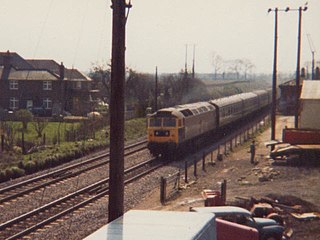
Kidlington railway station opened in 1855 on the Oxford and Rugby Railway to serve the adjacent Oxfordshire village of Kidlington, and act as a railhead for the town of Woodstock, 2.5 miles (4.0 km) away. It became a junction station in 1890 upon the opening of the Blenheim and Woodstock Branch Line, and served the area for over 100 years before falling victim to the programme of closures initiated by the Beeching Report in 1964. Following many proposals for its reopening, a new station to serve Kidlington opened in October 2015 at Oxford Parkway on the Oxford to Bicester Line.
The Eye Branch was a two miles 72 chains long single track branch railway line in Suffolk, England that ran from Mellis railway station on the Great Eastern Main Line to Eye via one intermediate station, Yaxley Halt. It was the shortest railway branch line in East Anglia to enjoy a regular passenger service.
The Llantrisant – Aberthaw line was a railway line built in two parts.
St Mary Church Road railway station was a railway station in the Vale of Glamorgan, South Wales.
Cowbridge railway station served the town of Cowbridge in the Vale of Glamorgan in Wales between 1865 and 1965. It opened along with the line on 30 January 1865 after multiple delays, which the engineer of the line blamed on bad weather. It was the biggest station on the Llantrisant-Aberthaw line by quite a considerable margin.
References
- ↑ Chapman, Colin (1984). The Cowbridge Railway. Poole: Oxford Publishing Company. ISBN 978-0-86093-284-0.
- ↑ "Ystradowen Village - Village History". Ystradowen village website. Archived from the original on 9 October 2011. Retrieved 9 April 2017.
| Preceding station | Disused railways | Following station | ||
|---|---|---|---|---|
| Llanharry | Taff Vale Railway Llantrisant-Aberthaw | Trerhyngyll and Maendy Halt |